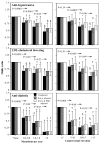Lower prevalence of hypertension, hypercholesterolemia, and diabetes in marathoners
- PMID: 19204599
- PMCID: PMC2813145
- DOI: 10.1249/MSS.0b013e31818c1752
Lower prevalence of hypertension, hypercholesterolemia, and diabetes in marathoners
Abstract
Purpose: To test whether the prevalence of hypertension, hypercholesterolemia, and diabetes declines with marathon participation independent of annual running mileage.
Methods: Cross-sectional associations of self-reported medication use in 62,284 male and 45,040 female participants of the National Runners' Health Study adjusted for age, diet, alcohol, and annual distance run.
Results: By self-report, 31.7% of men and 29.1% of women ran 0.2 and 0.8 marathons per year, 8.6% of men and 4.4% of women ran between 1.0 and 1.8 marathons per year, and 3.8% of men and 1.5% of women ran an average of >or=2 marathons per year. The men's odds ratio per marathons per year run was 0.85 for antihypertensive (P < 0.0001), 0.87 for LDL-cholesterol-lowering (P = 0.002), and 0.52 for antidiabetic medication use (P < 0.0001). Compared with nonmarathoners, men who averaged 0.2-0.8 marathons per year had 13% lower odds for antihypertensive medication use, 22% lower odds for LDL-cholesterol-lowering medication use, and 67% lower odds for antidiabetic medication use. Marathon participation was also associated with lower LDL-cholesterol-lowering and antidiabetic medication use in women, but not when adjusted for annual distance run. Each additional hour required to complete their marathon had odds ratio of 1.31 and 1.22 for men's antihypertensive and LDL-cholesterol-lowering medication use and 2.01 for women's antidiabetic medication use (all P < 0.0001). Among all runners (marathoners and nonmarathoners combined), prevalence in the use of all three medications decreased in association with the length of the longest usual run, independent of total annual mileage.
Conclusion: Prevalence of hypertension, hypercholesterolemia, and diabetes decreases with the frequency of marathon participation independent of annual running distance. This may be due to the inclusion of longer training runs in preparation for marathons or to genetic or other innate differences between marathon and nonmarathon runners.
Figures

References
-
- Balke B, Ware RW. An experimental study of physical fitness of Air Force personnel. US Armed Forces Med J. 1959;10:875–888. - PubMed
-
- Bergstrom J, Hermansen L, Hultman E, Saltin B. Diet, muscle glycogen and physical performance. Acta Physiol Scand. 1967;71:140–50. - PubMed
-
- Bouchard C, Daw EW, Rice T, et al. Familial resemblance for VO2max in the sedentary state: the HERITAGE family study. Med Sci Sports Exerc. 1998;30:252–258. - PubMed
-
- Colditz G, Martin AP, Stampfer MJ, Willett WC, Sampson L, Rosner B, Hennekens CH, Speizer FE. Validation of questionnaire information on risk factors and disease outcomes in a prospective cohort study of women. Am J Epidemiol. 1986;123:894–900. - PubMed
Publication types
MeSH terms
Substances
Grants and funding
LinkOut - more resources
Full Text Sources
Medical
Miscellaneous

